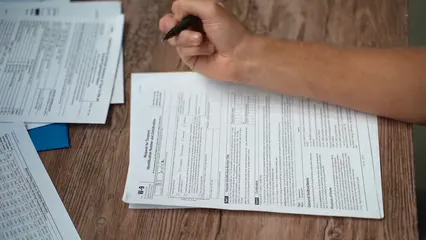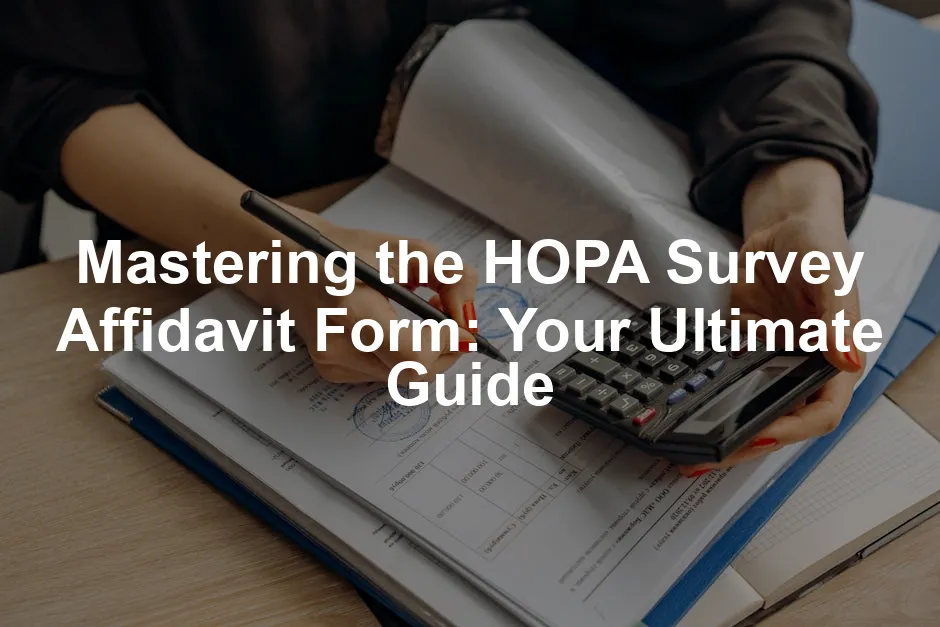Introduction
Navigating the labyrinth of real estate documentation can feel like a never-ending game of Monopoly—especially when you stumble upon the infamous HOPA Survey Affidavit Form. Fear not! We’re here to help you decode the mystery behind this essential piece of paperwork that can make or break your real estate transaction.
So, what does HOPA actually stand for? It’s the Housing for Older Persons Act. This federal law was crafted to ensure that age-restricted communities can maintain their unique character and protect residents from familial status discrimination. In simpler terms, it helps keep the “55 and over” sign on the door while ensuring that everyone follows the rules.
The HOPA Survey Affidavit Form serves as a key player in this process. It’s a legal document that confirms compliance with HOPA’s requirements, primarily that at least 80% of occupied units have a resident aged 55 or older. Why does this matter? Well, without proper documentation, communities could face hefty fines, legal battles, or even worse—losing their age-restricted status!
Imagine trying to sell your house, only to find out that your community isn’t compliant. Yikes! That’s why understanding and completing the HOPA Survey Affidavit Form correctly is a must for property owners, real estate agents, and residents alike.
Throughout this guide, we’ll shed light on the intricacies of this form, its legal implications, and how to complete it accurately. We’ll even sprinkle in some tips on avoiding common pitfalls along the way. Whether you’re a seasoned real estate agent or a first-time homebuyer, this guide will equip you with the knowledge you need to navigate the world of HOPA compliance with confidence.

Summary
In this ultimate guide to the HOPA Survey Affidavit Form, we’ll cover several key points that will spark your curiosity. First, we’ll discuss the purpose and importance of the HOPA Survey Affidavit Form, which serves as an essential tool in maintaining compliance within age-restricted communities.
Next, we’ll dive into the legal implications and responsibilities of property owners, emphasizing the potential consequences of non-compliance. Afterward, we’ll provide you with a step-by-step guide to completing the form accurately to ensure everything is in order.
Finally, we’ll explore how to utilize the form effectively in disputes. Whether you are a seasoned real estate agent or a first-time homebuyer, understanding the ins and outs of the HOPA Survey Affidavit Form can save you from potential legal pitfalls and ensure compliance in age-restricted communities. Let’s get started on this enlightening journey!

The Purpose of the HOPA Survey Affidavit Form
The HOPA Survey Affidavit Form is not just another piece of bureaucratic nonsense; it’s a critical tool for ensuring compliance with the Housing for Older Persons Act (HOPA). This form confirms that at least 80% of occupied units in a community are home to at least one resident aged 55 or older. Why is this significant? Well, it helps age-restricted communities maintain their unique character while protecting them from familial status discrimination.
Without this form, communities can face serious consequences. Imagine a neighborhood where everyone is over 55, but suddenly, a family with young children moves in. That could lead to legal challenges under the Fair Housing Act. The HOPA Survey Affidavit Form acts as a safeguard, ensuring that communities can continue to operate as intended. In essence, it keeps the “55 and over” sign on the door while allowing for the necessary legal protections.

For those wanting to delve deeper into real estate and its nuances, consider picking up Real Estate Investing for Dummies. It’s a fantastic resource that breaks down the complexities of real estate investing into digestible bites, perfect for beginners and seasoned pros alike.
Essential Components of the HOPA Survey Affidavit Form
Understanding the HOPA Survey Affidavit Form is like piecing together a jigsaw puzzle; each section plays a vital role in the overall picture. Here are the key components of this essential document:
- Identity of Declarant: This section captures the details of the person signing the affidavit. It includes their name, position, and any affiliations with the community. For example, if the signer is the property manager, their title should clearly reflect that.
- Survey Affirmation: Here, the form validates the community’s eligibility. It confirms that at least 80% of occupied units house residents aged 55 or older. This section should also express the community’s intent to operate as housing for older persons. For instance, it might state, “We affirm that our community meets the HOPA criteria.”
By ensuring these components are filled out accurately, communities can maintain their compliance status and avoid potential legal troubles down the line. Each detail matters, and together, they form a robust affirmation of adherence to HOPA regulations.

If you’re new to real estate, you might find The Homeowner’s Guide to Aging in Place an invaluable read. It provides insights into making homes more accessible and accommodating for those who want to live independently as they age.
Understanding the Entry Fields
Completing the HOPA Survey Affidavit Form may sound tricky, but it’s quite straightforward when you break it down. Each section requires specific information that helps confirm compliance with the Housing for Older Persons Act.
- Identity of Declarant: This part captures the information of the person filling out the form. You need to provide your name, title, and your relationship to the community. For example, if you’re the property manager, make sure to state that clearly.
- Residence Units: Here, you’ll need to mention the total number of units in the community. Additionally, differentiate the number of age-qualified units from non-age-qualified ones. Don’t leave any units out; it could lead to compliance issues.
- Survey Details: This section records the specifics of the most recent survey, including when it was conducted and how many residents participated. Accurate dates and numbers are crucial!
- Affirmation: Lastly, sign this part to declare under penalty of perjury that all information is true. This is your commitment to accuracy, so double-check before you sign.
To ensure accuracy, it’s wise to gather all necessary documents beforehand. Have a checklist ready! This can include previous survey results, resident age verification documents, and any relevant community policies. Always verify that the information matches what’s in your records. A little preparation goes a long way!

For those interested in furthering their real estate knowledge, check out The Real Estate Wholesaling Bible. It’s an essential guide for anyone looking to dive into the world of real estate wholesaling, packed with tips and strategies for success.
Filling in Accurate Information
When it comes to the HOPA Survey Affidavit Form, accuracy can’t be stressed enough. Common mistakes can lead to serious legal headaches. Here are a few pitfalls to avoid:
- Identity of Declarant: Ensure that your name and title are spelled correctly. Missing or incorrect details here can make the entire form invalid.
- Residence Units: Be meticulous when counting age-qualified units. It’s easy to miscount, especially in larger communities. Double-check your numbers against your records to avoid discrepancies.
- Survey Details: Make sure the survey date is current. If it’s been over two years since the last survey, you will need to conduct a new one before completing the form.
- Affirmation: Don’t skip this part! If you sign without verifying your information, you could face legal consequences.
Accurate information looks like this: “The community has 100 units, with 85 occupied by residents aged 55 or older.” An inaccuracy might state, “There are 100 units, and many are age-verified,” without concrete numbers. Clarity and specificity are your best friends in this process!

By avoiding these common mistakes and ensuring all information is accurate, you’ll sail through the completion of the HOPA Survey Affidavit Form with ease. Now, let’s move on to why thorough verification is essential!
Instances for Dispute Involving HOPA Survey Affidavit Form
Disputes surrounding the HOPA Survey Affidavit Form often arise in age-restricted communities. One common scenario involves discrepancies in resident ages. For instance, imagine a situation where a resident claims to be 55 or older but is found to be 54. Such a revelation could lead to significant complications, especially if it affects the community’s compliance status.
Another example is when the percentage of age-qualified residents is questioned. If a survey indicates that only 75% of occupied units have a resident aged 55 or older, the community may face legal action. Residents might argue that they were misled about the age restrictions when they moved in. These discrepancies can lead to disputes not just among residents but also between property owners and regulatory authorities.
Additionally, the accuracy of data collected in surveys can lead to disagreements. If a community fails to conduct its required biennial survey, or if inaccuracies in reporting arise, disputes can emerge regarding whether the community maintains its age-restricted status. For instance, if a community claims compliance but fails to provide adequate survey evidence, it could find itself in hot water.
In such cases, the HOPA Survey Affidavit Form serves as vital evidence in legal disputes. This form not only validates the community’s compliance with HOPA requirements but also details the steps taken to ensure that at least 80% of occupied units are age-qualified. If a community faces legal scrutiny, this affidavit can demonstrate their commitment to adhering to federal regulations. In essence, it can be the difference between maintaining the community’s status or facing fines and legal consequences.

Conclusion
Understanding and accurately completing the HOPA Survey Affidavit Form is crucial in today’s real estate landscape, especially within age-restricted communities. This form ensures compliance with federal laws, protecting the rights of residents and the integrity of the community. It serves as a safeguard against potential legal challenges that can arise from mismanagement or non-compliance.
The importance of this document cannot be overstated. Accurate completion helps maintain a community’s “55 and over” status, allowing residents to enjoy the benefits of living in a space tailored to their needs. It also allows property owners and real estate agents to avoid headaches that stem from legal disputes.
If you’re looking to dive deeper into the world of real estate, I highly recommend The Complete Guide to Selling Your Home. This guide is packed with tips that can help you sell your home faster and for a better price!
In case of uncertainty or complexity, seeking professional assistance is highly encouraged. Legal experts can provide guidance on completing the form and ensuring compliance with HOPA. After all, being informed is your best ally in navigating the intricacies of real estate transactions.
Ultimately, understanding the HOPA Survey Affidavit Form is not just about filling out a piece of paper; it’s about securing the future of age-restricted communities. By ensuring that all details are accurate and properly documented, you contribute to a thriving environment where residents can enjoy their golden years. So, take the time to familiarize yourself with this essential form and its implications. It could be the key to a successful real estate journey!

FAQs
What is the purpose of the HOPA Survey Affidavit Form in real estate transactions?
The HOPA Survey Affidavit Form is crucial for real estate transactions involving age-restricted communities. It serves as an official declaration confirming compliance with the Housing for Older Persons Act (HOPA). This federal law mandates that at least 80% of occupied units contain a resident aged 55 or older. By requiring this form, communities can maintain their age-restricted status and avoid potential legal issues. Without it, homeowners could face hefty fines and even lose their age-restricted designation. In essence, this form helps keep the “55 and over” sign firmly on the door.
What are the essential components of the HOPA Survey Affidavit Form?
The HOPA Survey Affidavit Form consists of critical sections that ensure its effectiveness. Firstly, it includes the Identity of Declarant, which records the name, title, and affiliation of the person signing. This identifies who is responsible for the information provided. Secondly, the Survey Affirmation validates the community’s compliance, affirming that at least 80% of occupied units are home to residents aged 55 or older. Each section must be filled out accurately to prevent legal repercussions and maintain compliance with HOPA regulations.
What are the legal implications of the HOPA Survey Affidavit Form?
Completing the HOPA Survey Affidavit Form carries significant legal implications. Property owners are responsible for ensuring that their communities comply with HOPA guidelines. Failing to adhere to these regulations can lead to serious consequences, including fines, legal actions, and the potential loss of age-restricted status. Misrepresentation on the form can also expose property owners and real estate agents to liability. Therefore, understanding the legal ramifications is paramount for anyone involved in age-restricted housing transactions.
How to correctly complete the HOPA Survey Affidavit Form?
Completing the HOPA Survey Affidavit Form requires attention to detail. Start with the Identity of Declarant, ensuring accurate personal information. Next, list the total number of residence units, clearly differentiating between age-qualified and non-age-qualified units. In the Survey Details section, document the most recent survey, including the date and participation rate. Finally, in the Affirmation section, the declarant must attest to the accuracy of the information provided. Double-check all entries to ensure they align with community records and avoid potential legal issues.
How does the HOPA Survey Affidavit Form impact dispute resolution in age-restricted housing communities?
The HOPA Survey Affidavit Form plays a pivotal role in resolving disputes within age-restricted housing communities. When conflicts arise—such as claims about the percentage of age-qualified residents—the affidavit serves as authoritative proof of compliance with HOPA. It can help settle disagreements regarding age qualifications and the community’s adherence to federal regulations. Additionally, if a legal dispute emerges, this form provides documented evidence of the community’s commitment to maintaining its age-restricted status, thereby supporting resolution efforts.
Please let us know what you think about our content by leaving a comment down below!
Thank you for reading till here 🙂
For more information on the HOPA Survey Affidavit Form, check out our detailed post on the HOPA Survey Affidavit Form.
All images from Pexels




